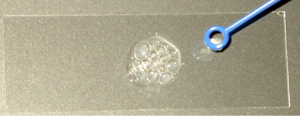27 Catalase Test
Emilie Miller, Ph.D
When an organism uses O2 in respiration, sometimes poisonous hydrogen peroxide, H2O2, is created. There are three ways this is known to occur.
- FADH2, carrying electrons from the Krebs cycle, can transfer electrons to O2 skipping the electron transport system (ETS) and producing H2O2.
- Flavoproteins, usually the initial electron carriers in the ETS, can transfer electrons directly to O2 bypassing the rest of the ETS. The incompletely reduced oxygen forms H2O2.
- In the last step of the ETS, an incomplete reduction can produce the superoxide radical O – which is then converted to H2O2 by the enzyme superoxide dismutase.
Organisms that produce H2O2 also produce the enzyme catalase which breaks H2O2 down into molecular oxygen and water.
H2O2 + catalase = H2O + ½O2
To test for the presence of catalase, hydrogen peroxide is dropped onto a mass of cells. If catalase is present, bubbles of O2 form immediately. The reagent can be dropped directly onto cells growing on the surface of a medium. However, you will perform the “slide test,” where cells are first placed on a clean surface and then the reagent is added. 
When performing the “slide test” you will use toothpicks to transfer cells to a clean surface. The order of steps is important! Many transfer instruments are composed of metals. Some metals can act as inorganic catalysts and facilitate the same reaction as the catalase enzyme does. If the hydrogen peroxide makes contact with the metal, you could see bubbles because of the interaction of the metal and the H2O2. This may produce a false positive result. While reading below, think about how the procedure (specific materials used, the order of steps) helps guard against a false positive in this regard.
Materials per student:
- H2O2
- Sterile toothpicks
- slides
Procedure Lab 1
- Remove the lid of the culture. Aseptically, use a sterile toothpick to transfer a visible amount of growth from the parent culture to the slide.
- Discard the toothpick immediately into the disposal container on the bench.
- In the same way, transfer each organism to the slide using a fresh sterile toothpick each time. Take care to keep each sample well away from the other samples on the inside of the plate.
- Gently add 2 drops of H2O2 solution onto each mass of cells. Take care to keep the reagent from one area rolling into an adjacent area.
- Place the lid on the plate to contain any aerosols produced by bubbling.
- Watch for bubbles.
- Record your data. For observations, briefly describe what you see, “bubbles” or “no bubbles.” Under result, indicate a positive or negative result. Under interpretation, think about what the result tells you about the biochemistry of the organism. The organism “makes catalase” or the organism “does not make catalase.”

